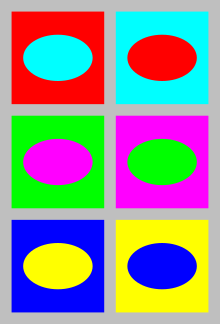


Complementary colors are pairs of colors which, when combined or mixed, cancel each other out (lose chroma) by producing a grayscale color like white or black.[1][better source needed] When placed next to each other, they create the strongest contrast for those two colors. Complementary colors may also be called "opposite colors".
Which pairs of colors are considered complementary depends on the color theory one uses:
- Modern color theory uses either the RGB additive color model or the CMY subtractive color model, and in these, the complementary pairs are red–cyan, green–magenta (one of the purples), and blue–yellow.
- In the traditional RYB color model, the complementary color pairs are red–green, yellow–purple, and blue–orange.
- Opponent process theory suggests that the most contrasting color pairs are red–green and blue–yellow.
- The black-white color pair is common to all the above theories.
These contradictions stem in part from the fact that traditional color theory has been superseded by empirically-derived modern color theory, and in part from the imprecision of language. For example, blue can be the complement of both yellow and orange because a wide range of hues, from cyan to blue-violet, are called blue in English.
- ^ Shorter Oxford English Dictionary, 5th Edition, Oxford University Press (2002) "A color that combined with a given color makes white or black."